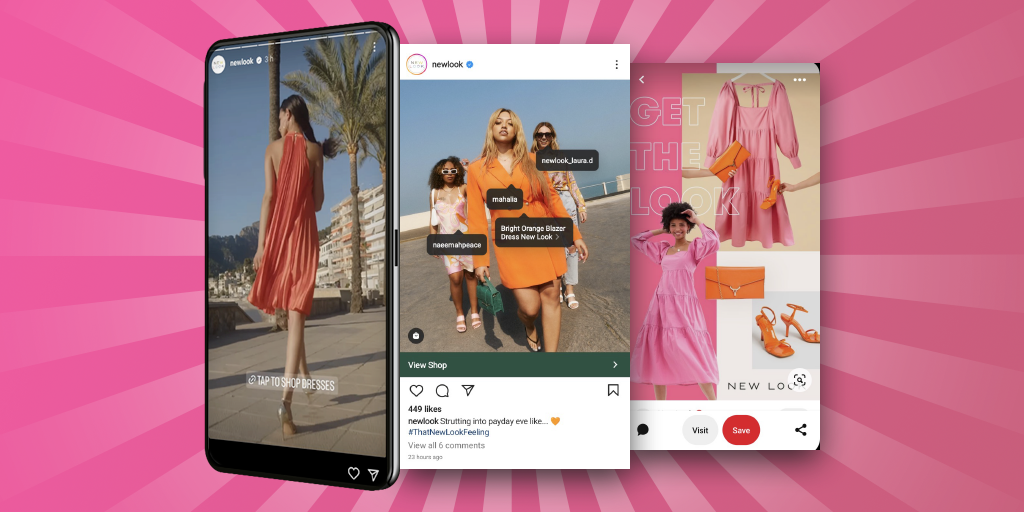Table of contents
- What is Social Commerce?
- How does Social Commerce differ to eCommerce?
- What are the main Social Commerce Platforms?
- How can you use Social Commerce across each platform?
- What are the key benefits of Social Commerce?
- Great Examples of Social Commerce Activity
- Tips, tools and Best Practices to stand out in social commerce
- Summary
What is Social Commerce?
Social Commerce is the process of selling and promoting products directly on social media platforms.
The major social commerce platforms globally are Instagram, TikTok, Facebook and Pinterest. WeChat in China has led the charge in Social Commerce innovation, with other platforms looking to replicate their success.
Unlike traditional social media marketing, social commerce predominantly focuses on allowing potential customers to research brands, discover items and purchase products without exiting the platform.
Examples of social commerce include:
-
In-platform native shops: Dynamically pull through product feeds to create social shop fronts
-
Shoppable influencer content
-
Organic and Paid shoppable posts
-
Marketplace peer-to-peer sales (as seen on Facebook)
-
Curated shopping lists (as seen on Pinterest)
-
Live shopping events (as seen on Facebook Live)
Testing different customer journeys with social commerce allowing shoppers to:
Click-to-buy directly in the platform
Click to in-app store before clicking through to purchase on the Brand’s eCommerce website or app
Click to messenger to speak to either a chatbot or a sales representative
How does Social Commerce differ to eCommerce?
eCommerce refers to creating a shopping experience on a brand’s website or app. Social Commerce allows the customer to make their purchase directly within the social media platform.
Many brands take a hybrid approach between eCommerce and Social Commerce, allowing shoppers to start their shopper journey within the social platform’s native shop before completing this on their own brand website or app. This may be the preferred route for brands who don’t want to (or do not have the means to) manage stock across multiple platforms.
What are the main Social Commerce Platforms?
Instagram, Facebook and WeChat (China) currently lead the way with Social Commerce, offering integrations with many key eCommerce platform catalogs and offering a suite of formats for brands and influencers.
TikTok are making huge strides in this area, partnering with an increasing number of platforms including Shopify, Square, Wix and more.
Pinterest is making social commerce a key area of development with API options and a Woocommerce Partnership.
How can you use Social Commerce across each platform?
We have provided a summary of key social commerce options across the major global social media platforms:
Instagram and Facebook:
Product tags: These link directly through to the in-platform stores, allowing users to click directly through to purchase
Organic Shopping Posts: Brands can create posts that link directly through to the in-platform store.
Paid Ads: Paid solutions allow greater targeting options including remarketing users who haven’t completed a purchase. Formats include: Carousel Ads, Dynamic Ads, Collection Ads, Instant Experience Ads in addition to standard image and video ads
Instagram Checkout: As with Facebook, shoppers can purchase directly within the social commerce platform – now made easier thanks to the shopping icon on the platform homepage
Facebook Shops: Facebook shops allow brands to create online stores for free – something that many SMBs adopted during the pandemic
Messenger ChatBot or Sales Assistant: For more complex purchases, adding a virtual or actual sales assistant helps bridge the gap between interest and purchase helps increase conversion rates
TikTok:
Product Tags: Single or multiple product tags can be added to both pre-recorded videos and TikTok Live
Paid Shopping ads: TikTok have a collection of different shopping ads including:
Collection Ads : These allow shoppers to swipe to an instant gallery experience
Lead Generation Ads: Shoppers can fill out an instant form which can be particularly useful for brands with longer sales cycles or for higher priced items (e.g. a kitchen suite)
Dynamic Showcase Ads: These are personalized based on the products that shoppers have expressed interest in on your app or website
Shoppable Pins on both organic and paid for ads
Idea Pins: This Instagram Stories-style format allows brands and influencers to add multiple shopping links
Collection Pins: Much like TikTok and Meta (Instagram and Facebook), Pinterest allows brands to create ads based on a collection of products
Paid Partnerships: Creators can disclose paid partnerships and add tags to featured products
Product Catalogue: In April 2021, Pinterest partnered with Shopify, augmenting their in-platform shopping experience. This allows users to navigate from the Product Listings Page on Pinterest directly into the Brand’s Product Description Pages
Influencer Storefronts:
Whilst not strictly Social Commerce, influencer content can be introduced into your eCommerce store through individual storefronts, offering shoppers a more engaged shopping experience
What are the key benefits of Social Commerce?
Social Commerce has become a powerful sales channel and is increasingly becoming a strategic focus for leading retailers and brands. According to Accenture, the global social commerce market was worth $492 billion in 2021 and is expected to reach $1.2 Trillion by 2025 – nearly tripling in just 4 years.
The benefits are far reaching and benefit both shoppers and brands.
A seamless shopping experience:
-
LEGO saw a 3.4X higher return on ad spend for click-to-messenger ads over ads that linked directly to the LEGO website
-
This frictionless experience in turn provides a more positive customer experience
A new revenue stream using an existing audience:
eMarketer forecast that one in three US users will make a purchase on Facebook in 2022 – that equates to 59.4 million buyers
For those with strong follower numbers, this offers a great opportunity to generate incremental revenue
An increase in Average Order Value:
-
The ease of purchase alongside engaging content from other shoppers and influencers, has been directly linked to generating higher AOVs
eCommerce SEO uplifts:
-
Social Commerce improves overall SEO performance for your eCommerce store thanks to additional links driving to your site
-
It also provides User Generated Content (from shoppers and influencers) to use for wider marketing
Reusable Content:
-
Don’t restrict Social Commerce content to social media platforms:
-
An influencer will also promote the content on their own channels, helping reach wider audiences and benefiting from their credibility
-
Consider integrating influencer content across your Product Details Pages (PDPs), the Product Listings Pages (PLPs) and/or within a dedicated influencer shop front
-
The best performing influencer content can be amplified by the brand as Organic and Paid Shoppable Posts
-
TikTok video content can be promoted across your wider digital channels
-
Shopper Feedback:
-
In addition to speeding up the transaction process, social commerce also curates shopper feedback in near real-time
-
This feedback can be used for future product development and to improve product descriptions and FAQs
Great Examples of Social Commerce Activity
Very:
-
Influencer integration within their branded channels
- Video product links
-
TikTok videos integrated into their other social channels (Instagram/Facebook)
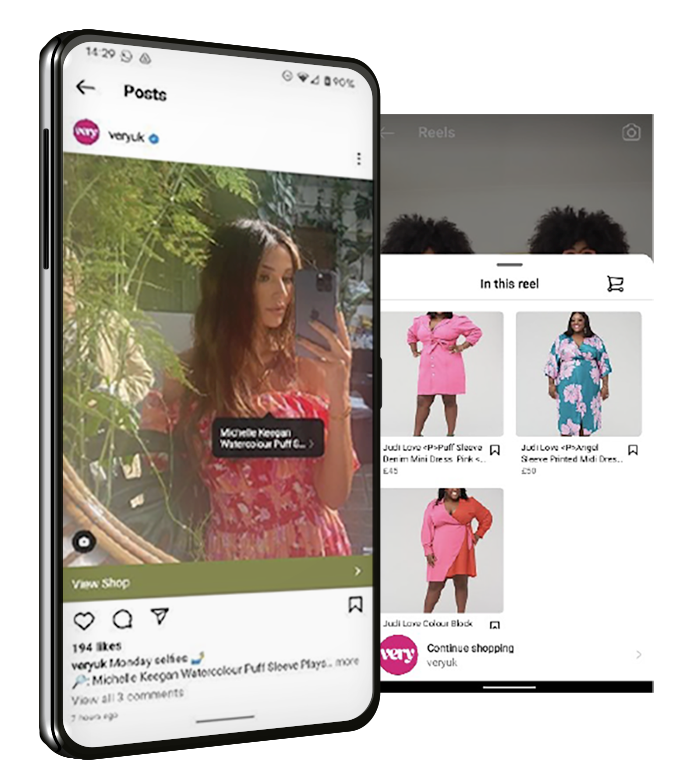
Wickes:
-
Combined Social Commerce and User Generated Content (UGC) on Instagram encourages engagement and builds trust
-
Building Product Discovery using Pinterest and #WithWickes ‘created’ pins
- #MyWickesMyWay DIY Hacks on TikTok inspires shoppers and links users straight to the products used in the transformation
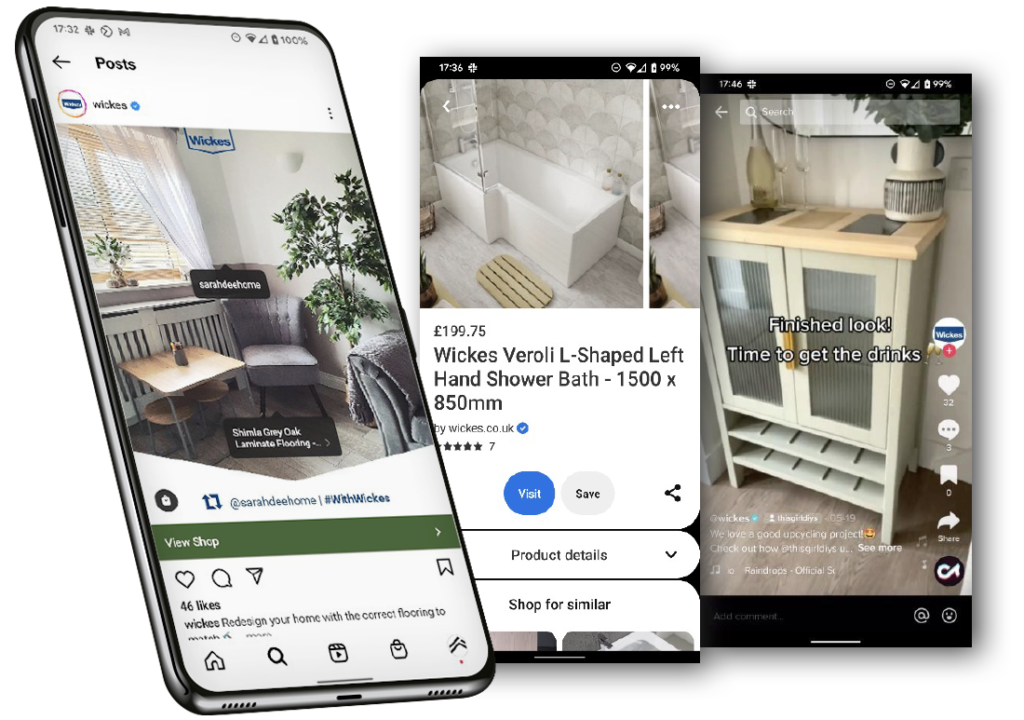
Fatface:
-
Frequent customer and influencer posts such as this example from sustainable influencer Rebecca Harvey
-
Mixing catalog pins with ‘created’ pins such as their shoppable ‘edits’
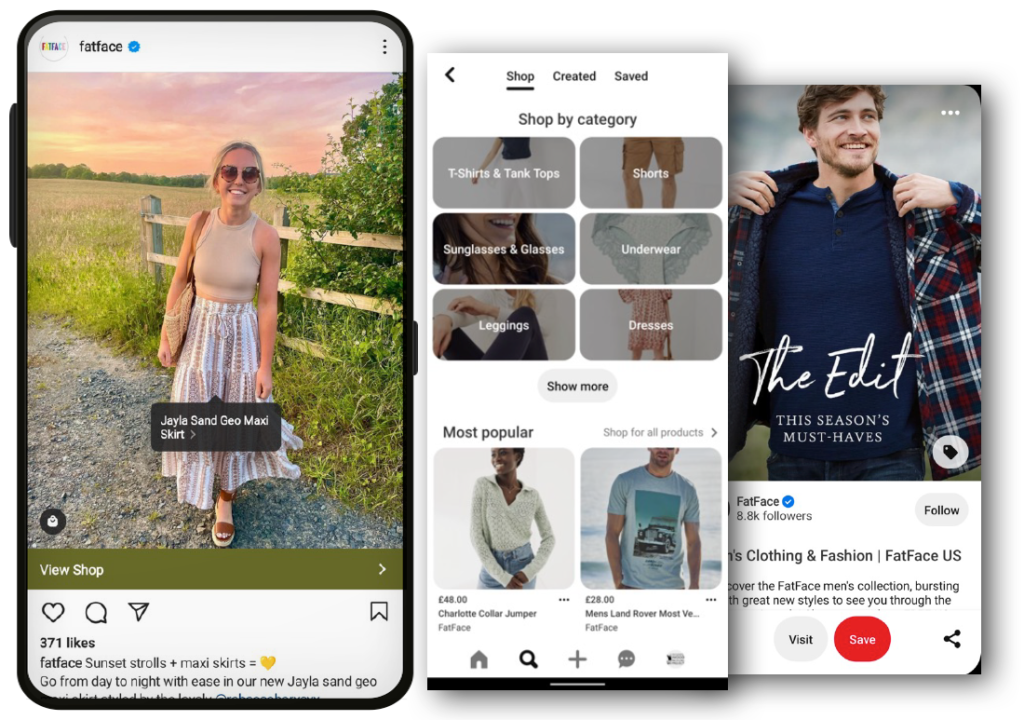
New Look:
-
Shoppable Video Stories on Instagram
-
Tagged influencer Instagram posts to extend reach and increase credibility
-
‘Get the look’ shoppable Pinterest pins
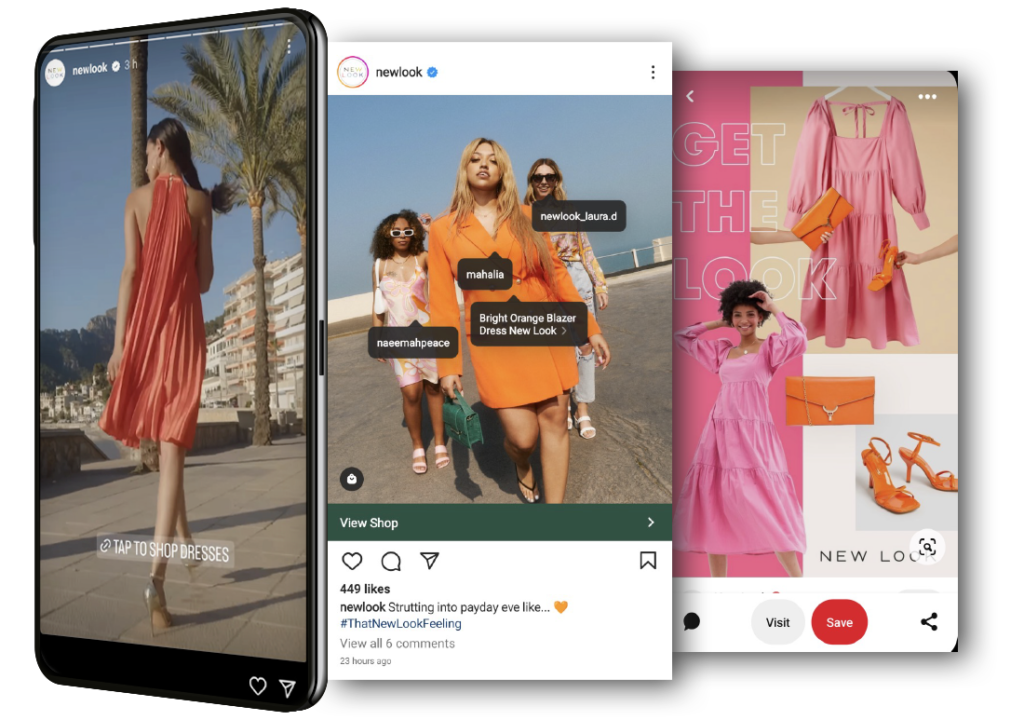
Tips, tools and Best Practices to stand out in social commerce
Experiment with AI Chatbots:
Chatbots help brands deliver customer service 24/7/365 helping fill the gaps when retail assistants cannot be online
If chatbots cannot answer the question, they are still able to triage the query or give shoppers alternative means to engage with the brand
Mirror physical in-store experiences:
-
If a shopper approached a sales assistant in a physical store, they’d expect an immediate response. Therefore, during key working hours, offering virtual sales assistants to talk to in addition to quickly responding to comments and DMs is key
-
Provide product availability and nearest physical store collection options
Integrate Social Proof:
-
Social proof messages do not have to be limited to your website or app. These can be carried further into your social channels with Taggstar’s social proof messaging solution
Proliferate content across channels:
-
TikTok videos offer creative features that appeal to consumers more widely. Make the most of your creative efforts and use this content across your other Owned channels such as Instagram, Facebook and within your eCommerce Product Details Pages (PDPs)
Summary
Social commerce is only set to grow and the brands that adopt this early and innovate across the platforms will reap the rewards.
This should be considered as part of a wider omnichannel strategy that engages with shoppers on their terms. With so many platforms now to consider, brands may be concerned about the sheer volume of content that’s required but those that make the most of these platforms know that strong content can be adapted to be used across a multitude of formats.
